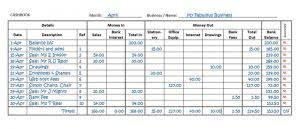
By understanding these factors, you can assess your company’s asset utilization and make informed decisions to improve your asset turnover ratio and boost profitability. An asset turnover ratio is considered low when a company is generating a small amount of sales relative to their assets. This indicates that the organisation is not effectively using its assets to generate revenue. A low asset turnover ratio suggests that a company might be experiencing issues with its asset management. It does not, however, necessarily imply that a company is mismanaging Cash Flow Management for Small Businesses its assets.
- Depreciation is the allocation of the cost of a fixed asset, which is expensed each year throughout the asset’s useful life.
- Conversely, a lower ratio indicates poor efficiency, which may be due to poor utilization of fixed assets, poor collection methods, or poor inventory management.
- To calculate revenue per seat, the total dollar amount of revenue earned on a given night is divided by the total number of available seats in the restaurant.
- A company can improve its ratio by increasing sales without significantly expanding its asset base or by selling underperforming assets.
- Efficiency ratios assess how well a company manages its assets and liabilities, focusing on how these assets generate revenue.
- To improve the asset turnover ratio, a company can increase sales, reduce its assets, or both.
In the final analysis
- So, you might find that your asset turnover ratio isn’t a totally accurate reflection of your current efficiency.
- Analysts began using asset turnover to evaluate how productively railroad, steel, and automotive companies were leveraging massive investments in capital-intensive assets to drive growth.
- A company with a high asset turnover ratio, such as 4.5, indicates that it generates $4.5 in sales for every dollar invested in assets.
- FAT measures a company’s ability to generate net sales from its fixed-asset investments, namely property, plant, and equipment (PP&E).
- In other words, when a company’s asset turnover is significantly higher than that of its competitors, it may be a warning flag.
A retail company may be charged an interest expense for the rent or lease of goods, equipment, buildings, or other items necessary for operations. A current ratio greater than one indicates that a company can pay its short-term debts using only short-term assets if liquidation is necessary. It is an indication of the company’s ability to pay for items in the short term, including food, beverages, and staff wages.
Online Investments
The asset turnover ratio is calculated bookkeeping by dividing revenue by average total assets, and revenue is always a positive number. This asset turnover ratio is also called the total asset turnover ratio and is mostly calculated on an annual basis. As a company’s total revenue is increasing, the asset turnover ratio can identify whether the company is becoming more or less efficient at using its assets effectively to generate profits. A decrease in asset turnover ratio may indicate that a company is not effectively using its assets to generate revenue. This may be due to several factors, including reduced demand for the company’s products or services, increased competition, or inefficiencies in the company’s operations. For manufacturing companies, a good asset turnover ratio may range from 1 to 2.5.

Asset Turnover Ratio vs Other Financial Ratios
As a result, these ratios should be used in conjunction with other financial metrics and qualitative assessments to gain a more holistic view of a company’s efficiency. The denominator of the formula for fixed asset turnover ratio represents the average net fixed assets which is the average of the fixed asset valuation over a period of time. The fixed assets include al tangible assets like plant, machinery, asset turnover ratio buildings, etc.
Remember that net sales only accounts for the products that end up in your customers’ hands at the end of the year—in other words, what they actually paid for. The asset turnover ratio is used to evaluate how efficiently a company is using its assets to drive sales. It can be used to compare how a company is performing compared to its competitors, the rest of the industry, or its past performance. Companies can artificially inflate their asset turnover ratio by selling off assets.
- It can help investors, managers, and analysts to evaluate the revenue efficiency of a company and compare it with its peers or industry benchmarks.
- This accounting principle is a peek into the efficiency of your business—whether or not you’re using the assets you have, both fixed and current, to generate sales.
- This metric is insightful to management as well as investors concerning the markup earned on products.
- This means that the company generated $1.18 of sales for every dollar of assets it owned in 2023.
- This may be due to several factors, including increased demand for the company’s products or services, improved operational efficiency, or more effective marketing strategies.

Asset turnover ratio is a financial metric that measures a company’s ability to generate revenue relative to the value of its assets. The resulting ratio represents the amount of revenue generated per dollar of assets. In other words, asset turnover ratio measures how efficiently a company is utilizing its assets to generate revenue. One of the key metrics to measure the efficiency of a business is the asset turnover ratio, which shows how well a company uses its assets to generate sales. The asset turnover ratio is calculated by dividing the net sales by the average total assets for a given period. A higher ratio indicates that the company is more efficient in using its assets, while a lower ratio suggests that the company is underutilizing its assets or has idle or obsolete assets.

The ratio calculates the company’s net sales as a percentage of its average total assets to show how many sales are generated from each dollar of the company’s assets. For instance, an asset turnover ratio interpretation of 1.5 would mean that each dollar of the company’s assets generates $1.5 in sales. The ideal asset turnover ratio varies by industry, but for retail companies, a good ratio may be between 2 and 4. This range suggests that a company is effectively utilizing its assets to generate revenue.